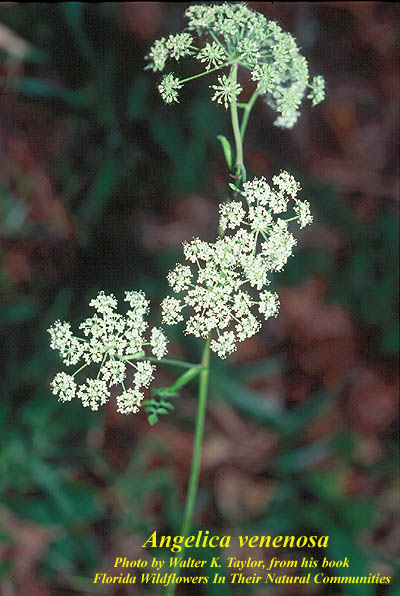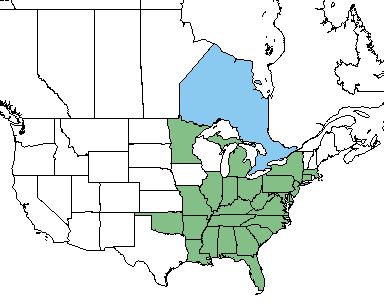Difference between revisions of "Angelica venenosa"
(→Ecology) |
HaleighJoM (talk | contribs) (→Ecology) |
||
| (12 intermediate revisions by 6 users not shown) | |||
| Line 1: | Line 1: | ||
{{italic title}} | {{italic title}} | ||
| − | Common name: | + | Common name: Hairy Angelica <ref name= "USDA Plant Database"/>, Deadly Angelica <ref name= "Weakley 2015"/> |
<!-- Get the taxonomy information from the NRCS Plants database --> | <!-- Get the taxonomy information from the NRCS Plants database --> | ||
{{taxobox | {{taxobox | ||
| Line 19: | Line 19: | ||
}} | }} | ||
==Taxonomic Notes== | ==Taxonomic Notes== | ||
| − | Synonyms: ''A. villosa'' (Walter) Britton, Sterns, & Poggenburg | + | Synonyms: ''A. villosa'' (Walter) Britton, Sterns, & Poggenburg.<ref name="weakley">Weakley, A.S. 2015. Flora of the southern and mid-atlantic states. Working Draft of 21 May 2015. University of North Carolina at Chapel Hill, Chapel Hill, North Carolina.</ref> |
| − | Varieties: none | + | Varieties: none.<ref name="weakley">Weakley, A.S. 2015. Flora of the southern and mid-atlantic states. Working Draft of 21 May 2015. University of North Carolina at Chapel Hill, Chapel Hill, North Carolina.</ref> |
==Description== | ==Description== | ||
<!-- Basic life history facts such as annual/perrenial, monoecious/dioecious, root morphology, seed type, etc. --> | <!-- Basic life history facts such as annual/perrenial, monoecious/dioecious, root morphology, seed type, etc. --> | ||
| − | ''A. venenosa'' is a perennial forb/herb of the ''Apiaceae'' family native to North America and introduced in Canada. <ref name="USDA Plant Database"> USDA Plant Database [https://plants.usda.gov/core/profile?symbol=ANVE https://plants.usda.gov/core/profile?symbol=ANVE] </ref> | + | ''A. venenosa'' is a perennial forb/herb of the ''Apiaceae'' family native to North America and introduced in Canada. <ref name="USDA Plant Database"> USDA Plant Database [https://plants.usda.gov/core/profile?symbol=ANVE https://plants.usda.gov/core/profile?symbol=ANVE] </ref> Unusual features of ''A. venenosa'' varieties found in dry sandhill communities in the Fall Line Sandhills include basal leaves that lay directly on the ground, small leaflets, and coarse, more equilateral toothing of the leaflets. <ref name= "Weakley 2015"/> |
==Distribution== | ==Distribution== | ||
| Line 32: | Line 32: | ||
==Ecology== | ==Ecology== | ||
===Habitat=== <!--Natural communities, human disturbed habitats, topography, hydrology, soils, light, fire regime requirements for removal of competition, etc.--> | ===Habitat=== <!--Natural communities, human disturbed habitats, topography, hydrology, soils, light, fire regime requirements for removal of competition, etc.--> | ||
| − | ''A. venenosa'' is found in dry forests and woodlands, woodland borders, longleaf pine sandhills, hammocks, and prairies. <ref name= "Weakley 2015">Weakley, A. S. (2015). Flora of the Southern and Mid-Atlantic States. Chapel Hill, NC, University of North Carolina Herbarium. </ref> Additionally, it is found in mesic woodlands | + | ''A. venenosa'' is found in dry forests and woodlands, woodland borders, longleaf pine sandhills, hammocks, and prairies. <ref name= "Weakley 2015">Weakley, A. S. (2015). Flora of the Southern and Mid-Atlantic States. Chapel Hill, NC, University of North Carolina Herbarium. </ref> Additionally, it is found in mesic woodlands, the sandy loam of savanna-like open pinewoods on gentle slopes adjacent to cypress-gum wet area, and shady beech magnolia-hickory-oak woods.<ref name = "FSU herbarium"> URL: http://herbarium.bio.fsu.edu. Last accessed: June 2018. Collectors: Loran Anderson, Bill and Pam Anderson, John Nelson, G. Knight, A.F. Clewell, Steve L. Orzell, Edwin L. Bridges, Rodie White, R. Kral, Brian R. Keener, Tracy Keener. States and counties: Florida (Santa Rosa, Leon, Jefferson, Jackson, Okaloosa) Georgia (Grady, Thomas) Alabama (Conecuh, Greene)</ref> |
| − | ===Phenology=== <!--Timing off flowering, fruiting | + | |
| − | + | ===Phenology=== <!--Timing off flowering, fruiting, and environmental triggers. Cite PanFlora website if appropriate: http://www.gilnelson.com/PanFlora/ --> | |
| + | ''A. venenosa'' has been observed to flower in January and June,<ref name= "PanFlora"> Nelson, G. PanFlora: Plant data for the eastern United States with emphasis on the Southeastern Coastal Plains, Florida, and the Florida Panhandle. www.gilnelson.com/PanFlora/ Accessed: 17 MAY 2018 </ref> but also is noted to flower from May through July.<ref name= "Lady bird">[[https://www.wildflower.org/plants/search.php?search_field=&newsearch=true]] Lady Bird Johnson Wildflower Center. Accessed: March 13, 2019</ref> | ||
| + | |||
<!--===Seed dispersal===--> | <!--===Seed dispersal===--> | ||
<!--===Seed bank and germination===--> | <!--===Seed bank and germination===--> | ||
| − | <!--=== | + | <!--===Pollination===--> |
| − | + | ||
| − | + | ===Herbivory and toxicology===<!--Herbivory, granivory, insect hosting, etc.--> | |
| + | ''Angelica venenosa'' has been observed to host seed bugs such as ''Lygaeus turcicus'' (family Lygaeidae).<ref>Discoverlife.org [https://www.discoverlife.org/20/q?search=Bidens+albaDiscoverlife.org|Discoverlife.org]</ref> This species is a value to beneficial insects by supporting conservation biological control through attracting predatory/parasitoid insects that prey on pest insects.<ref name= "Lady bird"/> | ||
| + | |||
<!--==Diseases and parasites==--> | <!--==Diseases and parasites==--> | ||
| − | ==Conservation and | + | ==Conservation, cultivation, and restoration== |
''A. venenosa'' is listed as a "special concern" species by the Connecticut Department of Environmental Protection. <ref name= "USDA Plant Database"/> | ''A. venenosa'' is listed as a "special concern" species by the Connecticut Department of Environmental Protection. <ref name= "USDA Plant Database"/> | ||
| − | == | + | ==Cultural use== |
==Photo Gallery== | ==Photo Gallery== | ||
<gallery widths=180px> | <gallery widths=180px> | ||
</gallery> | </gallery> | ||
==References and notes== | ==References and notes== | ||
Latest revision as of 14:20, 15 June 2022
Common name: Hairy Angelica [1], Deadly Angelica [2]
| Angelica venenosa | |
|---|---|

| |
| Photo by the Atlas of Florida Plants Database | |
| Scientific classification | |
| Kingdom: | Plantae |
| Division: | Magnoliophyta - Flowering plants |
| Class: | Magnoliopsida - Dicots |
| Order: | Apiales |
| Family: | Apiaceae |
| Genus: | Angelica |
| Species: | A. venenosa |
| Binomial name | |
| Angelica venenosa (Greenway) Fernald | |

| |
| Natural range of Angelica venenosa from USDA NRCS Plants Database. | |
Contents
Taxonomic Notes
Synonyms: A. villosa (Walter) Britton, Sterns, & Poggenburg.[3]
Varieties: none.[3]
Description
A. venenosa is a perennial forb/herb of the Apiaceae family native to North America and introduced in Canada. [1] Unusual features of A. venenosa varieties found in dry sandhill communities in the Fall Line Sandhills include basal leaves that lay directly on the ground, small leaflets, and coarse, more equilateral toothing of the leaflets. [2]
Distribution
A. venenosa can be found in the eastern half of the United States, ranging from Oklahoma and Minnesota to Florida and Massachusetts. It has also been introduced in Canada, specifically in Ontario. [1]
Ecology
Habitat
A. venenosa is found in dry forests and woodlands, woodland borders, longleaf pine sandhills, hammocks, and prairies. [2] Additionally, it is found in mesic woodlands, the sandy loam of savanna-like open pinewoods on gentle slopes adjacent to cypress-gum wet area, and shady beech magnolia-hickory-oak woods.[4]
Phenology
A. venenosa has been observed to flower in January and June,[5] but also is noted to flower from May through July.[6]
Herbivory and toxicology
Angelica venenosa has been observed to host seed bugs such as Lygaeus turcicus (family Lygaeidae).[7] This species is a value to beneficial insects by supporting conservation biological control through attracting predatory/parasitoid insects that prey on pest insects.[6]
Conservation, cultivation, and restoration
A. venenosa is listed as a "special concern" species by the Connecticut Department of Environmental Protection. [1]
Cultural use
Photo Gallery
References and notes
- ↑ 1.0 1.1 1.2 1.3 USDA Plant Database https://plants.usda.gov/core/profile?symbol=ANVE
- ↑ 2.0 2.1 2.2 Weakley, A. S. (2015). Flora of the Southern and Mid-Atlantic States. Chapel Hill, NC, University of North Carolina Herbarium.
- ↑ 3.0 3.1 Weakley, A.S. 2015. Flora of the southern and mid-atlantic states. Working Draft of 21 May 2015. University of North Carolina at Chapel Hill, Chapel Hill, North Carolina.
- ↑ URL: http://herbarium.bio.fsu.edu. Last accessed: June 2018. Collectors: Loran Anderson, Bill and Pam Anderson, John Nelson, G. Knight, A.F. Clewell, Steve L. Orzell, Edwin L. Bridges, Rodie White, R. Kral, Brian R. Keener, Tracy Keener. States and counties: Florida (Santa Rosa, Leon, Jefferson, Jackson, Okaloosa) Georgia (Grady, Thomas) Alabama (Conecuh, Greene)
- ↑ Nelson, G. PanFlora: Plant data for the eastern United States with emphasis on the Southeastern Coastal Plains, Florida, and the Florida Panhandle. www.gilnelson.com/PanFlora/ Accessed: 17 MAY 2018
- ↑ 6.0 6.1 [[1]] Lady Bird Johnson Wildflower Center. Accessed: March 13, 2019
- ↑ Discoverlife.org [2]